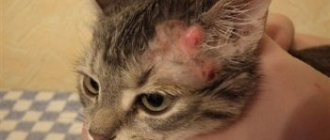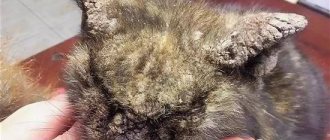Alena Igorevna Goncharenko
veterinarian Petstory
Dermatitis in cats is not a disease, but a symptom of many diseases, characterized by inflammatory processes in the skin due to various damaging factors. It can manifest itself in the form of skin redness, crusts, pimples, dry skin and itching. There is no breed, age or gender predisposition to the occurrence of feline dermatitis. Both indoor and outdoor cats are susceptible to this disease.
Is there a genetic predisposition to dermatoses?
Some researchers assign a key role in the development of many diseases to genetic predisposition. (1) Indeed, sometimes dermatoses in cats have a hereditary (breed) predisposition. For example, such as idiopathic dermatitis of the face (Persian and Himalayan cat breeds suffer), ulcerative dermatitis of the nose (observed in Bengal cats), cutaneous mastocytosis (the disease has been reported in Sphynx and Devon Rex cats). (2–5)
It is not known for certain how genetically inherited dermatitis in cats is accompanied by itching (for example, allergic dermatitis). However, itching itself as a condition is extremely debilitating. This is what prompts researchers to study the causes of itching and look for possible options for its control, including medications.
Mechanisms of itching formation
In veterinary medicine, the following definition is accepted: itching is an unpleasant sensation that causes the desire to scratch. It should be noted that it was previously assumed that itching and pain (as sensations) are close to each other, since the paths of their development are identical. (6−8) However, over time, researchers have discovered differences in the mechanisms of development of itch and pain. Specifically, findings from positron emission tomography of the brain revealed that the perception of pain is processed by the primary and secondary somatosensory cortices, while the perception of itch is processed by the prefrontal and primary somatosensory cortices, premotor areas, and anterior cingulate cortex. (9–13) Moreover, the areas of the brain that perceive sensitive information about itching and pain largely overlap each other. That is, identical areas that perceive these sensations still exist. Of course, there is still no complete clarity on this issue.
An equally important aspect is to understand which mediators can cause itching, pain and inflammation. It is believed that the predominant mediators of itching are histamine, interleukin-31 and substance P, and the predominant mediators of pain are interleukin-6/-8, tumor necrosis factor, hydrogen ions, calcitonin gene-related peptide, adenosine triphosphate. Mediators that may be involved in the development of both itching and pain include endothelin, tryptase, nerve growth factor, and acetylcholine. Along with this, gastrin-releasing peptide, neurotrophins, kallikreins, proteases, leukotrienes, prostaglandins and other inflammatory mediators that can activate nerve fibers and sensitize them play a role in the development of itching. In addition to IL-31, a number of other interleukins (for example, IL-2,4,13) are also involved in the development of itching. (14–23)
Main causes of itching in cats
In various sources you can find information on data showing the relationship between various dermatitis in cats, including those accompanied by itching. According to the authors of one such publication, there are ten most common skin problems in cats, including:
- flea infestation;
- flea allergy;
- dermatophytosis;
- otodectosis;
- food allergies;
- allergies to environmental allergens;
- hypersensitivity caused by other factors (when the causes are not established);
- otitis;
- superficial bacterial skin infection;
- psychogenic alopecia. (24)
According to a study on hypersensitivity dermatitis in cats, itching may be caused by:
- flea allergy – in 29% of cases;
- food allergies – in 12% of cases;
- allergies to environmental allergens – in 20% of cases;
- hypersensitivity caused by various other factors (when the causes have not been established) - in 15% of cases;
- other diseases (ectoparasitic, autoimmune, fungal, tumor, psychogenic, viral, bacterial, idiopathic, as well as external otitis) - in 24% of cases. (25)
There are probably four main groups of causes that cause itching in cats:
- parasitic skin diseases;
- skin infections (bacterial and fungal);
- allergies (to flea saliva, to food factors, to environmental allergens);
- other (including rare) skin diseases (mastocytoma, mastocytosis, some viral infections, psychogenic itching and others).
Diagnosis of pathology in a veterinary clinic
Since different types of dermatitis have similar external manifestations, additional methods are required for an accurate diagnosis. To identify flea dermatitis, dermatologists use intradermal allergy tests. An allergen is injected into the animal's skin and the reaction is recorded. In cats with flea allergies, this administration causes intense redness, swelling and itching.
In addition, an allergic reaction causes changes in the blood, or more precisely, an increase in the level of eosinophilic leukocytes. In addition to a general analysis, you can do an immunogram, but this type of diagnosis is technically more complex and expensive, so it is resorted to only if it is difficult to make a diagnosis.
Clinical manifestations of itching in cats
In cats, with most dermatitis accompanied by itching, one of the so-called clinical patterns can be detected. Among these patterns are:
- miliary dermatitis (a rash consisting of papules that may be covered with yellowish crusts; photo 1);
Photo 1. Miliary dermatitis
- self-induced (self-induced) alopecia (loss of hair in places where they are normally present, caused by the patient’s actions: combing, licking, etc.; photo 2);
Photo 2. Self-induced alopecia
- itching in the head/neck area (photo 3), usually accompanied by excoriation (scratching);
Photo 3. Itching in the scalp
- eosinophilic granuloma complex, or eosinophilic dermatitis.
We should tell you more about the last pattern. Eosinophilic granuloma complex is a collective term used to refer to a group of lesions in cats that can be found on the skin, mucous membranes, and skin-mucous interface. Histological examination of such lesions reveals eosinophils. The most likely causes of their occurrence are allergies (to insect bites, to food, etc.). Among the lesions from this group in cats are:
- Indolent (eosinophilic) ulcers (Photo 3) are lesions that typically occur on the skin and mucous membranes of the lips in cats. As a rule, ulceration is painless, but may be accompanied by the development of a secondary bacterial infection;
- eosinophilic plaques are usually multiple lesions raised above the surface of the skin, often erythematous (reddened), may be ulcerated, and also have necrotic changes in the form of a whitish coating on their surface. The size of these lesions can reach several centimeters. Accompanied by itching;
- eosinophilic granulomas are lesions that are found on the skin, mucous membranes and at the interface of the skin and mucous membranes. Can be quite large in size (for example, linear granuloma can be observed along the entire length of the caudal surface of the femurs in cats). On palpation these are dense lesions. They rise above the surface of the skin and can be round, oval, or linear in shape; may have an erythematous or yellowish color. Often accompanied by itching. In the oral cavity, they can be found both on the mucous membranes of the palate and on the tongue, and have signs of ulceration and necrosis. They got their name due to the fact that histological examination, in addition to eosinophils, reveals signs of granulomatous dermatitis. (26)
Photo 4. Indolent ulcer
The listed clinical patterns can be observed individually or in one or another combination in one patient. This feature of clinical manifestations, with all the variety of skin diseases with itching, can allow the use of clinical criteria only as an auxiliary and weak diagnostic tool.
Symptoms and signs
Symptoms of atopic dermatitis begin to appear at any age. But most of the observed patients in the practice of veterinary dermatologists are less than 1 year old. They are sensitive to various drugs. There may be diseases that mimic atopy, such as ectoparasites , which must first be excluded before making a diagnosis of atopy.
Differentiating problems include: food allergies, dermatophytosis, demodicosis, Malassezia dermatitis, pemphigus foliaceus and bacterial pyoderma. You will find the entire list in a larger and more detailed article about atopic dermatitis in cats.
A good history is required to diagnose veterinary dermatology cases. Before diagnosing atopy, take a detailed medical history.
For example:
- Age at which skin problems begin
- Where do you spend your time most often - indoors or outdoors?
- Presence of other pets in the house.
- Are there other people with skin problems?
- Does a cat react to hormones?
- Seasonality of symptoms
Clinical signs of atopic dermatitis vary widely:
- Itching: on the face (varies from hair loss on the ears to severe facial irritation involving the eyes, preauricular areas, commissures of the mouth or chin), rectal, trunk,
- Otitis media is waxy with or without infection. It can be constant, weak due to infection with recurrent fungal otitis. Bacterial otitis also occurs, but not as often as waxy and fungal otitis.
- Eosinophilic granuloma
- Complex lesions
- Alopecia of the hock joints
- Acne on the chin
- Combs
Clinical approach to a cat with pruritus
It is probably a given that once a practitioner has encountered a cat suffering from itching, he cannot know anything about the cause that led to it. The only thing that is possible in this case is to make a list of differential diagnoses.
This is a key aspect on which the authors of various scientific publications focus the attention of readers. For example, in one of the articles devoted to allergies to environmental allergens, you can find a logical statement: before discussing this diagnosis, other causes of itching and dermatitis should be excluded. The authors suggest taking into account the following diseases, depending on the nature of the skin manifestations:
- for miliary dermatitis:
flea allergy, food allergy, dermatophyte infection, bacterial folliculitis, otodectosis, cheyletiellosis, pemphigus foliaceus, drug reaction; - for self-induced alopecia:
flea allergy, food allergy, demodicosis (caused by D. gatoi), dermatophyte infection, Malassezia dermatitis, psychogenic alopecia, lower urinary tract disease; - for itching in the head/neck area:
flea allergy, food allergy, demodicosis (caused by D. gatoi), notoedrosis, otodectosis, dermatophyte infection, superficial and deep bacterial skin infection, Malassezia dermatitis, viral infections (herpesvirus, papillomavirus, calicivirus, poxvirus, caused by feline leukemia virus), skin neoplasms (lymphoma, mastocytoma, squamous cell carcinoma), adverse reaction to the use of drops for treatment against ectoparasites, drug reaction, pemphigus foliaceus; - with eosinophilic granuloma complex:
flea allergy, food allergy, infections caused by mycobacteria, nocardiosis, fungal diseases (sporotrichosis), viral diseases, skin neoplasms (lymphoma, mastocytoma, squamous cell carcinoma), deep bacterial skin infection, diseases accompanied by the formation of sterile granulomas ( for example, xanthomatosis). (27)
Thus, the list of possible causes of dermatitis accompanied by itching in cats is quite extensive. It should be noted that itching may not occur in all cases: for example, in the presence of indolent ulcers in cats, the affected area of the lips usually does not cause visible concern and can only occur in the presence of a secondary bacterial infection. Since it is impossible to establish a diagnosis based only on clinical symptoms, a so-called step-by-step algorithm is carried out.
Caring for a sick pet
Caring for a sick pet is not very difficult. It is necessary to follow all the recommendations of the attending physician, such as washing with special shampoos, treating affected areas of the skin with antiseptic solutions and ointments, and using medications internally. You should come for repeat examinations on time to assess the dynamics of treatment, since all animals are individual and even with the same diagnosis, the approach to treatment will differ.
Diagnostic algorithm for itching in cats
This algorithm is not much different from that for dogs and assumes:
- taking anamnesis;
- clinical examination;
- conducting routine dermatological tests to exclude parasites, infections and other (rare) causes leading to the development of dermatitis accompanied by itching.
In some clinical cases, diagnosis will require a fine-needle biopsy and additional diagnostic tests (PCR, histological examination of the skin and some others).
Dermatological tests performed at the initial appointment of a cat with itching
Speaking about routine dermatological tests, we should mention LUM diagnostics, trichogram, skin scrapings, tape test, ear smears, smears from the surface of skin lesions, wet paper test (photo 4), culture on nutrient media to exclude dermatophytoses . In some cases, visual inspection using a magnifying glass may be used.
Photo 5. A wet paper test helps determine the presence of a flea infestation.
Routine diagnostics will exclude the presence of:
- flea infestation;
- pediculosis;
- notoedrosis;
- cheyletiellosis;
- otodectosis;
- thrombiculosis;
- demodicosis, including that caused by D. gatoi. Note that in some cases it is impossible to detect the parasite D. gatoi, and therefore a “test treatment” can be carried out with a drug for cats from the isoxazoline group;
- dermatophyte infection, which in some cases may be accompanied by itching (photo 5).
Photo 6. Trichogramma. Hair affected by dermatophytes
Pet treatment
Treatment of dermatitis in animals is based on an integrated approach. When examined in a clinic, the doctor is obliged to identify dermatitis from other pathologies that have similar symptoms. These are psychogenic alopecia, staphylococcal pyoderma, lichen, dermatophytosis, cheyletiellosis.
After confirming the absence of the above ailments, the specialist diagnoses dermatitis, identifies its cause, puts the pet on a special diet and prescribes medications to prevent secondary infection. In severe cases, treatment is carried out in the clinic using droppers and regular medical monitoring of the animal’s condition. The lack of therapeutic measures leads to complete or partial baldness of the pet.
Therapy largely depends on the cause that caused the dermatitis. Parasites are controlled using special anti-flea and anthelmintic drugs. Currently, fipronil-based flea products have proven themselves to be effective. When treating atopic dermatitis, conditions of contact with the provoking agent are excluded.
For any form of the disease, the following scheme is relevant:
- treating the affected area with an antiseptic and carefully removing hair (cutting);
- secondary antiseptic treatment of the affected area, removal of crusts;
- lubricating problem areas with an ointment that contains an antibiotic (for example, Levomekol, Tetracycline and others on the advice of a veterinarian);
- wearing a blanket for animals, which prevents licking of the ointment;
- your pet taking a drug that relieves itching (Dexamethasone, Dexafort);
- if necessary, placing an IV;
- if the pet’s health is very poor, allergic dermatosis or neurodermatitis is detected, it can be left in the clinic under observation;
- often additional antibiotics are prescribed (not only for infections, but also for significant skin lesions) or fungicides (for fungal dermatitis);
- for chemical dermatitis, regular washing of the affected areas and lubricating them with wound-healing preparations will be required;
- getting rid of dermatitis can be long-term and ends with the animal’s complete recovery or the disease becoming chronic (if the veterinarian prescribed the wrong therapy or the pet owner did not follow the treatment plan).
Traditional treatment, with the consent of the veterinarian, can be supplemented with traditional methods. You should prepare tea tree, cedar, lavender oils and soapy water. Mix in equal parts and treat problem areas before or after bathing.
In everyday life, it may happen that acid or alkali gets on the fur or skin of an animal. In this case, you should immediately neutralize the acid with a soda solution, and the alkali with vinegar. First, rinse the affected area thoroughly with water at a comfortable temperature for the animal.
In the future, it is important to show your pet to a veterinarian, which will prevent the occurrence of dermatitis.
Identifying the causes of allergies in cats
If there is no evidence that the patient has parasites, skin infections, or rare diseases, then further diagnostic actions are aimed at excluding various causes of allergies.
Flea allergic dermatitis
This is a common cause of itching in cats. It may be accompanied by other causes of allergies in cats (food allergies and feline atopic syndrome).
In most cases, flea dermatitis in cats is not accompanied by flea infestation, so most often it is not possible to visually determine the presence of a problem such as an allergy to flea bites. Therefore, appropriate treatments of the premises are carried out; cats/cats with itching, as well as all animals in contact with her/them.
Pyrethroids and insect growth regulators are commonly used for indoor treatment. Neonicotinoids, phenylpyrazoles, macrocyclic lactones, isoxazolines and insect growth regulators, which are part of complex preparations, are used to treat cats.
To confidently exclude the presence of flea allergic dermatitis, treatment procedures are carried out from 9 to 12 weeks. (27)
Food allergies
Food allergies in cats should be eliminated through an elimination diet. For this purpose, diets with a new source of protein, as well as hydrolysis diets, can be used.
In some cases, transferring cats to diagnostic diets is impossible due to the animals’ refusal to accept the proposed diet. Practical experience indicates that the soy hydrolysis diet PRO PLAN® VETERINARY DIETS HA ST/OX HYPOALLERGENIC has an obvious advantage in this regard - it is perfectly consumed by cats. In addition, the food is balanced in terms of the presence of nutrients cats need, which is important and is an additional incentive for the doctor when choosing a product for diagnosing food allergies. The diet is prescribed to cats for a period of 8 to 10 weeks; some doctors use the diagnostic diet for a longer period – up to 12–13 weeks. After this time, the patient's clinical condition is assessed. If symptoms of itching and inflammation are absent or they are much less pronounced than at the time of starting the diet, cats are given a food challenge, which usually lasts 2 weeks. For a challenge test, the diet that preceded the elimination diet is usually used. Symptoms may return quickly (within days or even minutes) or increase gradually. (27)
It is important to note: if the doctor uses medications to relieve itching and inflammation, they must be discontinued until the elimination diet is completed. Depending on the severity of symptoms and the drug used, this discontinuation may occur 1 to 3 weeks before clinical evaluation of the patient.
It should also be mentioned that usually both diagnostic steps - ruling out flea and food allergies - are carried out simultaneously. Their beginning and end usually coincide in time, i.e. flea treatment and diet begin on the same day and last, for example, exactly 10 weeks.
Adverse food reactions (ADR), including food allergies, are quite common in dogs and cats. Thus, according to one of the publications, for the creation of which the authors evaluated several hundred different scientific articles, the share of undesirable food reactions that are accompanied by skin lesions in dogs accounts for:
- 1% of the total number of diseases;
- 5% of all skin diseases;
- 15%–20% of the number of diseases accompanied by itching;
- 10%–25% for allergic skin diseases.
In addition, according to various estimates, about a third of dogs suffer from atopic dermatitis (in general, all these figures are similar to those in cats). (28)
Because the symptoms of ADRs are similar to allergies to environmental allergens, (27) it is critical to use strict diets to diagnose adverse food reactions to avoid diagnostic errors.
Feline atopic skin syndrome (FASS) is a diagnosis of exclusion
The concept of “feline atopic syndrome”
(Feline atopic syndrome, FAS) is associated with a number of diseases associated with hypersensitivity. The clinical manifestations of these diseases are very diverse. The pathological process may involve the skin, gastrointestinal tract, and respiratory system. In some cases, a combination of different symptoms is possible. For example, one patient may have skin lesions and asthma.
Feline atopic skin syndrome
Feline atopic skin syndrome (FASS), a newly introduced term (in place of the previously used atopic dermatitis), refers to the skin manifestations of hypersensitivity, usually associated with a reaction to environmental allergens, although food allergies may also be a cause. (27)
ACC is established based on the exclusion of all other causes of itching in cats. If such a diagnosis is established, and the practitioner does not consider it necessary to use additional diagnostics, then treatment includes drug therapy aimed at relieving itching and inflammation of the skin.
If the doctor considers it necessary to include allergen-specific immunotherapy (ASIT) in the treatment regimen, then this requires subsequent diagnostics. It consists of either skin or serum tests (Figure 1, Photo 6). They are necessary to identify environmental allergens that cause ASCVD for the purpose of vaccination with them (carrying out ASIT).
Photo 7. Skin tests. Test result evaluation
Figure 1. The result of a blood serum test in a cat. An increase in IgE levels against allergens of house dust mites and fleas was detected
First aid
The owner must provide the pet suffering from dermatitis with the most comfortable conditions and strictly follow all the veterinarian’s recommendations. Self-medication will cause irreparable harm to health, because the allergen that provoked the disease may well be hidden in the home medicine cabinet. Under no circumstances should you independently select or change medications prescribed by a veterinarian, or reduce or increase the dosage!
As first aid, you can give your four-legged pet the “Stop Itching” suspension to weaken the effect of the irritant. You should not smear the affected areas of the skin with anything, as this will significantly complicate the diagnosis in a veterinary clinic.
To prevent your cat from picking at sores, lightly file his claws and put on a light blanket to prevent infection from entering the wounds.
Swelling of the paws indicates that the dermatitis is most likely caused by an allergy to cat litter. In this case, you need to replace the contents of the tray, choosing a composition without small particles and odorless.
Drug therapy aimed at relieving itching and inflammation of the skin
Experts from the International Committee on Allergic Diseases in Animals assessed the effectiveness of a number of products that can be used to relieve itching and inflammation of the skin (the publication was devoted to feline atopic syndrome). (29) The authors of the article concluded that glucocorticoids should be considered effective. Possible recommendations may be the use of methylprednisolone at a dose of 1.5 mg/kg/day or triamcinalone at a dose of 0.18 mg/kg/day. Upon achieving remission, it is necessary to strive for the minimum effective dose (for example, the amount of glucocorticoids used can be reduced to 25% relative to the initial dosage). It is advisable to give these drugs as infrequently as possible to maintain clinical effect. Cyclosporine should also be considered effective. This drug is given in an amount of 7 mg/kg once daily. Its dose can be reduced to twice a week in more than 50% of patients. Oclacitinib is considered to be moderately effective (itching is relieved in approximately 50% of cases). It is usually used at a dosage of about 1 mg/kg every 24 hours or every 12 hours. This drug is registered only for dogs. There are also no long-term studies regarding its use in cats. (29)
Treatment
Do not give medicine to your animal unless it is prescribed by a veterinarian!
Treatment of allergic dermatitis should begin when the first symptoms are detected. If you start a disease, it will not be easy to cure it.
To treat flea dermatitis, the cat must be immediately treated for fleas (Frontline and Advantix drops show good results).
Use medications containing an active ingredient such as fipronil. These medications provide the most effective, and most importantly, quick results.
- For food allergic dermatitis, a special diet and hypoallergenic food are needed.
- For bacterial infections, antimycotic ointment and other similar drugs are used, and a course of antibiotics is also prescribed.
- Anti-inflammatory medications are also prescribed for contact allergic reactions. A prerequisite for treatment is to avoid contact with allergens.
- Quincke's edema claims the lives of many cats every year because it can cause sudden death. That is why there is no time to think and panic! You need to act confidently and quickly. Call the veterinarian immediately or take the animal to the clinic! The only thing you can do for your pet is to take him to the hospital as soon as possible. There he will be given antihistamines. If things get really bad, adrenaline will be injected into the heart muscle.
General rules for the treatment of all types of allergic dermatitis.
Control itching and avoid prolonged scratching. To do this, you can use veterinary medications with glucocorticosteroids, for example, Dexafort. It effectively relieves the animal from itching and helps in the fight against allergens. Due to constant scabies, animals develop wounds and scratches.
Therefore, it is important to prevent infection from getting into them. To do this, the veterinarian will definitely prescribe antibiotics and antimicrobial drugs. Veterinarians prescribe antihistamines (“Clemastin”, “Diphenhydramine”, “Chlorpheniramine”) for the complex treatment of allergic dermatitis. In some specific (advanced) cases, non-steroidal anti-inflammatory drugs and immunosuppressants are prescribed.
A good and safe remedy that reduces itching and increases the body's defenses is fish oil.
- To make the use of local medications (ointments, creams, sprays) more effective, the hair near the wounds can be cut off, that is, a therapeutic haircut must be performed.
- Wounds on cats can be washed with weak decoctions of anti-inflammatory herbs (celandine, chamomile and string).











